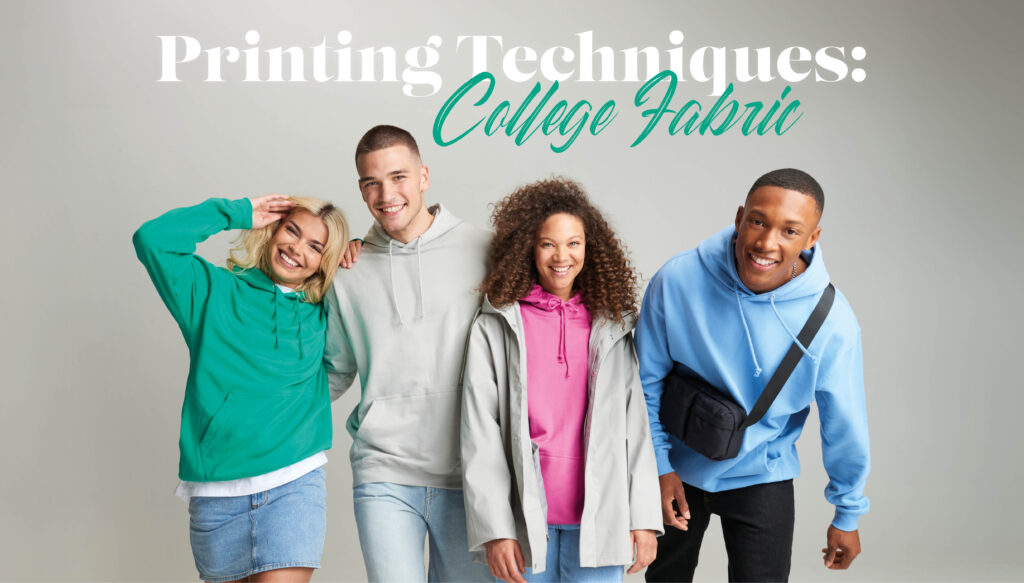Whether you are trying new print techniques, or mastering established ones, the fabric you choose will determine the quality of the finish, and the longevity of the designed garment.
So, what exactly makes our fabric (used to create our iconic JH001) a cut above the rest?
Our market leading AWDis College fabric has a 100% cotton face which gives it a smooth flat surface, ensuring an even spread of ink and the best quality prints.
The percentage of polyester in the garment also helps to keep the garments shape, ensuring a long-lasting print – even with frequent washing!
Let’s dive into Direct-to-Garment (DTG), Screen Printing, and Embroidery to understand how they work and why they are the standout players on our super-soft College Fabric.
1. DTG (Direct-to-Garment Printing)
DTG printing is a revolution in the world of fabric customisation. It’s the perfect choice for those who crave intricate, colourful designs with unparalleled detail.
DTG printing employs a specialised inkjet printer designed to print directly onto the fabric’s surface. This technique is best suited for cotton garments, ensuring the ink bonds well with the fabric, resulting in vibrant, long-lasting prints.
Our smooth 100% cotton face means you can achieve highly detailed DTG prints including intricate and vibrant designs, making it a popular choice for college-themed garments.
AWDis DTG Pro Tips
- Ensure pre-treatment ratios are correct to achieve bold and long-lasting prints.
- Always pre-press the garment before printing to reduce moisture and allow the cotton to best absorb the ink.
2. Screen Printing
Screen printing has been a classic choice for custom fabric designs, thanks to its longevity and cost-effectiveness. Screen printing involves creating a stencil (screen) for each colour in your design. Ink is then pressed through these screens onto the fabric, layer by layer, resulting in a crisp, well-defined image.
Our 100% Ringspun Cotton face is smooth and tightly knitted, achieving even and bold prints without overloading the garment with ink. The vibrancy will remain even after countless washes, which is ideal for sportswear and casual attire.
Plastisol inks are great for pantone matching and with a huge range of 87 colours, your imagination is your limit!
AWDis Screen Printing Pro Tips
- Make sure you use an anti-migration layer on those brighter bolder colours.
- Avoid prints cracking by curing at the correct temperature and time – always test print and cure.
3. Embroidery
Embroidery offers a classic and timeless approach to college fabric customisation, adding a touch of sophistication to your garments.
Embroidery uses special sewing machines to stitch your design into the fabric. The result is a textured, high-quality image that can withstand frequent use and washing.
Embroidery is the go-to for college crests, logos, or emblems, giving your fabric a refined and sophisticated appearance – our College Fabric was just made for it!
AWDis Embroidery Pro Tips
- Ensure you use a stabiliser on the inside of the garment, behind your embroidery and make sure your needle is smooth and sharp to avoid snagging.
- Consider your artwork, as a large amount of embroidery could cause some puckering around the design.
By now, you may be wondering which of these techniques is right for your college fabric printing needs. The answer depends on your design, budget, and desired level of detail. DTG printing is perfect for vibrant, intricate designs, while screen printing is great for bulk orders and long-lasting wear. Embroidery, on the other hand, adds an elegant touch to college merchandise.
If you’re eager to create your own custom merchandise, we’ve got you covered. To help you make an informed decision, we’ve put together a comprehensive College Fabric print guide.
